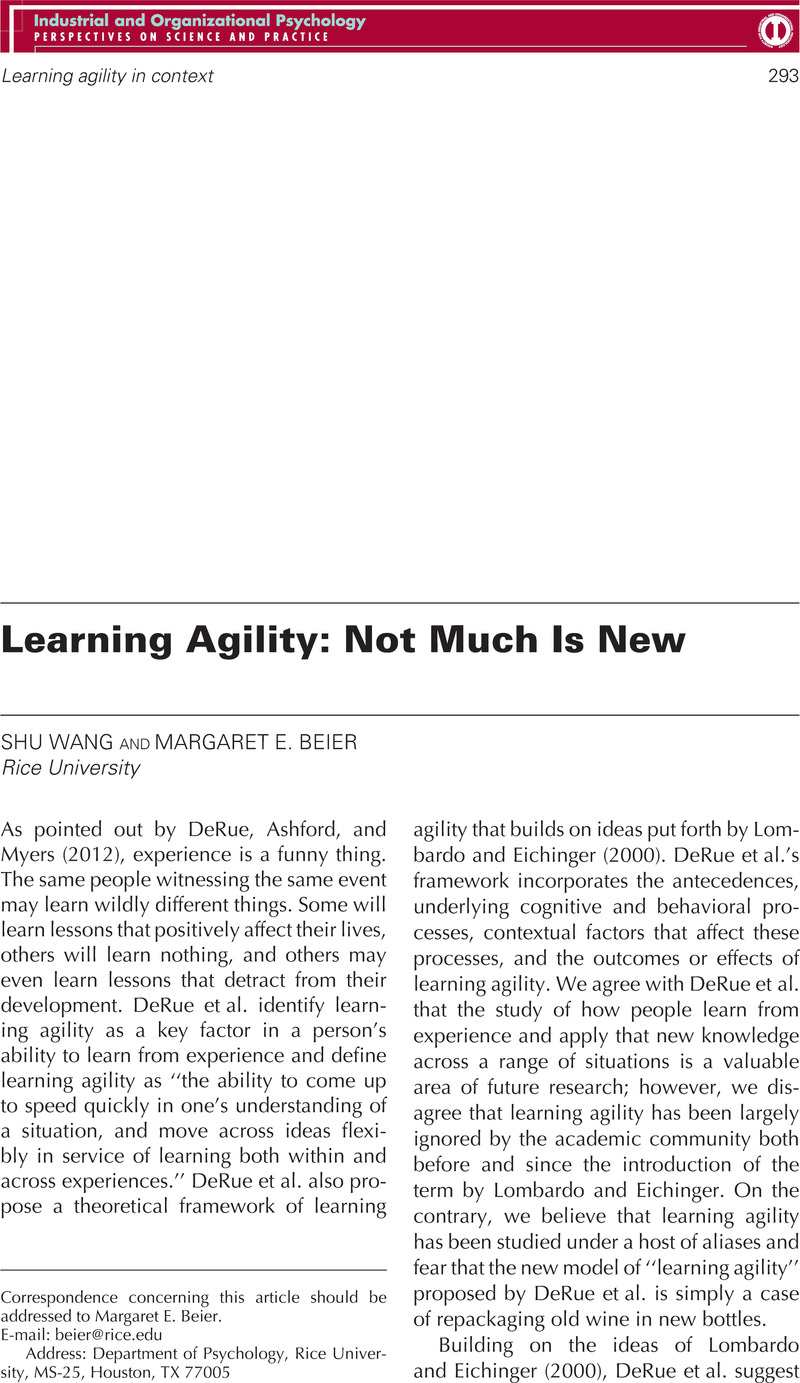Crossref Citations
This article has been cited by the following publications. This list is generated based on data provided by Crossref.
DeRue, D. Scott
Ashford, Susan J.
and
Myers, Christopher G.
2012.
Learning Agility: Many Questions, a Few Answers, and a Path Forward.
Industrial and Organizational Psychology,
Vol. 5,
Issue. 3,
p.
316.
Noe, Raymond A.
Clarke, Alena D.M.
and
Klein, Howard J.
2014.
Learning in the Twenty-First-Century Workplace.
Annual Review of Organizational Psychology and Organizational Behavior,
Vol. 1,
Issue. 1,
p.
245.
Noe, Raymond A.
and
Tews, Michael J.
2014.
Workplace Well‐being.
p.
142.
류혜현
and
Oh,Hun-Seok
2016.
Learning agility: Issues and Challenges.
The Korean Journal of Human Resource Development Quarterly,
Vol. 18,
Issue. 4,
p.
119.
Im, Changhyun
이효선
and
WEE YOUNG EUN
2017.
A study on the development of the learning agility scale.
The Korean Journal of Human Resource Development Quarterly,
Vol. 19,
Issue. 2,
p.
81.
Rotolo, Christopher T.
Church, Allan H.
Adler, Seymour
Smither, James W.
Colquitt, Alan L.
Shull, Amanda C.
Paul, Karen B.
and
Foster, Garett
2018.
Putting an End to Bad Talent Management: A Call to Action for the Field of Industrial and Organizational Psychology.
Industrial and Organizational Psychology,
Vol. 11,
Issue. 2,
p.
176.
Jeong Hong In
and
Sung Sesilia
2018.
The effect of learning agility on organizational citizenship behavior: Focused on the mediating effects of work engagement.
The Journal of Lifelong Education and HRD,
Vol. 14,
Issue. 1,
p.
139.
박정열
and
Kim Jin-Mo
2019.
The Development of Workplace Learning Agility Assessment Inventory for Knowledge Workers.
The Korean Journal of Human Resource Development Quarterly,
Vol. 21,
Issue. 4,
p.
115.
Kim, Gayoung
and
Lee, Woo Jin
2021.
The Venture Firm’s Ambidexterity: Do Transformational Leaders Boost Organizational Learning for Venture Growth?.
Sustainability,
Vol. 13,
Issue. 15,
p.
8126.
Deepa, V.
Sujatha, R.
and
Baber, Hasnan
2021.
Ageing and Learning Agility –Mediating role of learning perception and Moderating role of technology leverage.
International Journal of Lifelong Education,
Vol. 40,
Issue. 5-6,
p.
514.
Bouland-van Dam, Sophie I. M.
Oostrom, Janneke K.
and
Jansen, Paul G. W.
2022.
Development and validation of the leadership learning agility scale.
Frontiers in Psychology,
Vol. 13,
Issue. ,
Lee, Jinju
and
Song, Ji Hoon
2022.
Developing a measurement of employee learning agility.
European Journal of Training and Development,
Vol. 46,
Issue. 5/6,
p.
450.
Lee, Jinjoo
and
Song, Ji Hoon
2022.
Developing a Conceptual Integrated Model for the Employee's Learning Agility.
Performance Improvement Quarterly,
Vol. 34,
Issue. 4,
p.
367.
Wagner, Daniela
2023.
Lernen 4.0.
p.
83.
Montaño, Vicente E.
and
Viado, Myrna S.
2024.
Comparing Promotability Outlooks: Industry Professionals vs. MBA Student Perspectives.
European Journal of Contemporary Education and E-Learning,
Vol. 2,
Issue. 1,
p.
112.
Saputra, Nopriadi
and
Jafar, Bayanti Umi
2024.
Uncovering the Impact of Digital Mastery on Learning Agility in Electronics Manufacturing Companies.
p.
1.
Nayak, Lagna
and
Malik, Pooja
2024.
Two decades of learning agility and an integrated framework: a review of literature and bibliometric analysis.
International Journal of Organizational Analysis,
Vol. 32,
Issue. 10,
p.
2549.



